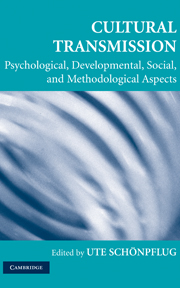Book contents
- Frontmatter
- Contents
- Foreword
- Contributors
- 1 Introduction to Cultural Transmission: Psychological, Developmental, Social, and Methodological Aspects
- 2 Theory and Research in Cultural Transmission: A Short History
- PART ONE EVOLUTIONARY PERSPECTIVE
- PART TWO CROSS-CULTURAL PERSPECTIVE
- 6 An Ecocultural Perspective on Cultural Transmission: The Family across Cultures
- 7 Intergenerational Relations and Cultural Transmission
- 8 Intergenerational Transmission, Social Capital, and Interethnic Contact in Immigrant Families
- 9 Developmental Processes Related to Intergenerational Transmission of Culture: Growing Up with Two Cultures
- 10 The Transmission Process: Mechanisms and Contexts
- 11 Accounting for Parent–Child Value Congruence: Theoretical Considerations and Empirical Evidence
- 12 Culture, Migration, and Family-Value Socialization: A Theoretical Model and Empirical Investigation with Russian-Immigrant Youth in Israel
- 13 Immigrant Parents' Age Expectations for the Development of Their Adolescent Offspring: Transmission Effects and Changes after Immigration
- PART THREE INTRACULTURAL VARIATIONS
- Index
- References
12 - Culture, Migration, and Family-Value Socialization: A Theoretical Model and Empirical Investigation with Russian-Immigrant Youth in Israel
Published online by Cambridge University Press: 05 June 2012
- Frontmatter
- Contents
- Foreword
- Contributors
- 1 Introduction to Cultural Transmission: Psychological, Developmental, Social, and Methodological Aspects
- 2 Theory and Research in Cultural Transmission: A Short History
- PART ONE EVOLUTIONARY PERSPECTIVE
- PART TWO CROSS-CULTURAL PERSPECTIVE
- 6 An Ecocultural Perspective on Cultural Transmission: The Family across Cultures
- 7 Intergenerational Relations and Cultural Transmission
- 8 Intergenerational Transmission, Social Capital, and Interethnic Contact in Immigrant Families
- 9 Developmental Processes Related to Intergenerational Transmission of Culture: Growing Up with Two Cultures
- 10 The Transmission Process: Mechanisms and Contexts
- 11 Accounting for Parent–Child Value Congruence: Theoretical Considerations and Empirical Evidence
- 12 Culture, Migration, and Family-Value Socialization: A Theoretical Model and Empirical Investigation with Russian-Immigrant Youth in Israel
- 13 Immigrant Parents' Age Expectations for the Development of Their Adolescent Offspring: Transmission Effects and Changes after Immigration
- PART THREE INTRACULTURAL VARIATIONS
- Index
- References
Summary
INTRODUCTION
Values are a core component of culture (Hofstede, 1980; Schwartz, 1999). Early theorists described values as the cultural heritage, passed from one generation to the next, that allows individuals to function efficiently in their social environment and to preserve the structure of society (Mannheim, 1952; Mead, 1934). Cross-cultural studies of intergenerational value transmission are few in number, however. This chapter addresses some of the core issues relevant to the study of value transmission across cultures. We focus on the interplay of culture, migration, and parenting style as they relate to socialization processes.
We first propose two different processes through which parenting style and culture may affect value socialization. We then consider the role of parenting style in diverse cultures, focusing on Russian-immigrant and veteran-Israeli youth. Then we examine acculturation attitudes and acculturation contexts as they relate to value socialization in immigrant families. Finally, we briefly discuss implications of the findings for cross-cultural studies of value socialization.
The family is an open system in which parents and children influence one another and in which input from the environment influences them both (O'Connor, Hetherington, & Clingempeel, 1997; Whitchurch & Constantine, 1993). Figure 12.1 presents five contexts that constitute this system: parental, child, parent–child dyadic, family, and ecological. Ecological refers to the wider community and culture in which the family is embedded (Bronfenbrenner, 1986). For each context, Figure 12.1 specifies a nonexhaustive list of the aspects likely to affect parent–child value congruence.
- Type
- Chapter
- Information
- Cultural TransmissionPsychological, Developmental, Social, and Methodological Aspects, pp. 269 - 296Publisher: Cambridge University PressPrint publication year: 2008



